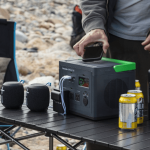The Evolution of DJing: A Brief Dive into Its Dynamic History
There’s a certain magic that comes with the art of DJing. Picture this: a room pulsating with rhythm, beats seamlessly blending into one another, and a crowd swaying in unison, lost in the euphoria of music. Behind the decks stands the DJ, curating this enchanting experience. But have you ever wondered how we got here? How did the world of DJing evolve from its humble beginnings to the dazzling spectacle we know today?
Whether you’re an avid music enthusiast or an aspiring DJ, tracing the history of DJing offers a deeper appreciation for the craft. It’s a journey that tells the tale of technology, talent, innovation, and instinct. But more than that, understanding this evolution is about recognizing the dedication of countless individuals who, through their passion for music, have shaped the soundscape of our lives.
For music enthusiasts, this history adds depth to every beat drop or smooth transition they hear. Knowing the story behind the art makes each listening experience richer. For DJs, understanding the past offers insights into the future, shaping their skills and techniques in an ever-evolving industry.
So, as we embark on this journey together, let’s turn back the clock and dive into the vibrant tapestry of DJing’s history. A world where vinyl records ruled the roost, where the introduction of digital technology reshaped the landscape, and where the fusion of old and new creates the electrifying performances we witness today.
The Early Days: Phonographs and Turntables – Setting the Beat for Modern DJing
Long before the glow of LED lights illuminated DJ booths and before powerful software simulated vinyl scratching, the art of DJing had a much humbler, analog beginning. Let’s rewind to the times when phonographs ruled, and turntables were just making their debut.
The Mighty Phonograph:
The first chapter in the story of DJing starts with the phonograph. This device was invented by Thomas Edison in 1877, this device was the dawn of recorded sound, not just a tool to play music. While Edison’s initial intention wasn’t to get people grooving on the dance floor, the phonograph laid the foundation for the future of music playback and recording.
These early phonographs used cylindrical recordings, which eventually gave way to flat discs – records as we recognize them today. DJs, or “disc jockeys”, got their name from these discs. The jockeys were steering the musical experience, using these discs as their trusted steeds.
Enter the Turntable:
Fast forward to the 1930s and 40s, and we witness another pivotal moment in the DJ world: the rise of radio disc jockeys. These pioneers had the crucial job of selecting and playing records on the airwaves, introducing audiences to new tunes and setting the nation’s mood. However, in the clubs and party scenes of the 1970s, the turntable truly found its home.
The turntable allowed for a new level of interaction with music. DJs could manually control the record’s speed, play it backward, or hold it still. From this, the techniques of scratching and beat-mixing emerged. Scratching, the art of moving the vinyl back and forth under the needle, created a unique sound that became synonymous with hip-hop culture. Beat-mixing, on the other hand, was about ensuring one song flowed into the next seamlessly, keeping the dancefloor alive and kicking.
The journey from phonographs to turntables is not just about technology but about the human spirit of innovation and creativity. These early tools were the canvases upon which DJs painted their masterpieces, setting the stage for an industry that would continue to evolve and influence global culture.
The Rise of Vinyl: Golden Age of DJing
Cue the glimmering disco balls, the pulsating basslines, and the unmistakable crackle of a vinyl record. The 70s and 80s weren’t just decades; they were an era that celebrated music in a way the world had never seen before. Central to this celebration was the vinyl record, and in its grooves, DJs found a playground of sonic possibilities.
Vinyl: More Than Just Music:
To understand the 70s and 80s, one must recognize the vinyl record’s cultural significance. Vinyl wasn’t just a medium for music; it was a statement. Owning a collection was a testament to one’s musical taste, and flipping through those large, artistically packaged records was an experience. For DJs, vinyl was the tool of the trade, the medium that gave them the freedom to innovate, experiment, and drive the cultural beat of the time.
Enter the 12-inch Single:
As vinyl became popular, a new format debuted: the 12-inch single. This wasn’t just a larger piece of vinyl; it was a game-changer. With wider grooves and longer playtimes, the 12-inch single gave DJs more room to play. They could extend breaks, amplify beats, and provide longer dance mixes. The dance floors of iconic clubs like Studio 54 pulsed with extended versions of popular tracks, all thanks to the newfound flexibility of the 12-inch format.
DJ Techniques Take Center Stage:
With the tools at hand, DJs of this era pushed boundaries and crafted techniques that still influence the industry today. Beat juggling, where DJs would alternate between two records to create a new rhythm, showcased their dexterity. Phrasing, where DJs aligned two songs to sound harmonious when played together, was another innovation of the time. And let’s remember the iconic needle drop, a technique of placing the needle on a record’s specific point to sync beats perfectly. The vinyl era gave DJs a tactile connection to their music, and a world of creativity sprang from that touch.
Fueled by vinyl’s tactile and auditory wonders, the golden age of DJing reminds us that sometimes the most profound innovations aren’t about the next big tech but about revisiting and reinventing the familiar. As the stylus glided through the grooves of countless records during this era, DJs didn’t just play music; they sculpted soundscapes, ensuring their place in the annals of music history.
Transition to CDs: Embracing the Digital Era in DJing
Picture this: It’s the late 80s, and DJs are on the brink of a seismic shift in the industry. As the glinting reflections of disco balls dance across club ceilings, a new player enters the arena, sleek and shiny: The Compact Disc, or CD. With it comes a wave of technological advancements and a debate that would split the DJ community right down the middle.
CDJs: The Future is Compact:
Emerging in the late 80s and gaining prominence in the 90s, the CDJ (Compact Disc Jockey) marked a pivotal moment in the world of DJing. These were digital players specifically designed for DJs, combining the tactile interface they were familiar with and the digital benefits of CDs. DJs no longer confined to the grooves of a vinyl record, now had a vast digital playground to explore.
Game-Changing Advancements:
CDJs weren’t just a replacement for turntables; they were an upgrade. With features such as precise cueing, loop functions, and pitch control, DJs found themselves with tools that expanded their creative horizons. Imagine pinpointing an exact moment in a track with laser precision or looping a specific section seamlessly for an extended mix. While possible with vinyl, these capabilities were streamlined and enhanced with CDJs.
Vinyl Purists vs. The CDJ Generation:
However, as with any significant change, the rise of CDJs sparked a debate. On one side were the vinyl purists, who believed in the authenticity and warmth of analog sound. They argued that the tactile connection between DJ and vinyl, the needle’s touch, and the analog’s rawness were irreplaceable. On the other side were the proponents of CDJs, who highlighted the flexibility, convenience, and expansive potential of digital mixing. This debate wasn’t just about technology; it touched on the essence of DJing – the blend of artistry and technique.
While the warmth of vinyl and the precision of CDs each have their merits, the transition to CDJs underscores an essential truth in the world of DJing: evolution is inevitable. As DJs continue to push the boundaries of sound, the blend of old and new, analog and digital, truly defines the art of the mix.
Software Revolution: The Dawn of the Digital DJ Workstations
As the millennium turned, the world of DJing was set for another transformation. Gone were the days when DJs would lug around hefty crates of vinyl or stacks of CDs to gigs. The new era beckoned with the promise of compactness, limitless possibilities, and futuristic mixing techniques. Enter the age of digital DJ workstations.
Unleashing the Power of Software:
If the CDJ was a leap, software platforms like Traktor, Serato, and Virtual DJ were quantum jumps. These programs didn’t just digitize the DJing process; they redefined it. Providing interfaces mirrored traditional setups, these software solutions offered various tools that took mixing, cueing, and scratching to unforeseen dimensions.
Rise of the Laptop DJ:
The ‘ Laptop DJ ‘ emerged with this new software in their arsenal. No longer was it necessary to have a physical medium like vinyl or CDs. The laptop became the epicentre of the DJ setup. This change was met with some scepticism. Traditionalists questioned the authenticity of the Laptop DJ, while many others embraced the convenience and possibilities it presented. Over time, as software grew more sophisticated and DJs showcased the creative potentials of digital platforms, the Laptop DJ earned their place in the profession’s pantheon.
The Digital Advantage:
So, what made these digital workstations so alluring? For starters, portability was a game-changer. DJs could perform anywhere with a laptop and a controller, from the most intimate gatherings to grand stage setups. Then came the advantage of having vast music libraries at their fingertips. No longer bound by the physical limitations of vinyl or CDs, DJs could access thousands of tracks and samples on-the-go, allowing for unparalleled versatility in their sets. Additionally, the advanced mixing tools provided by these software platforms – from intricate FX manipulations to multi-deck mixing – propelled DJing into a new age of innovation.
The software revolution showcased the beauty of evolution in the DJ world. Embracing digital workstations was not about letting go of tradition but about expanding the horizons of what was possible. As with every twist and turn in the history of DJing, it reiterated a timeless truth: the art is not just in the tools but in the hands that wield them.
Controllers and Modern-Day Setups: Fusing Tradition with Tomorrow
In a world constantly oscillating between nostalgia and innovation, the realm of DJing offers an exquisite dance between the past and the future. And nowhere is this marriage more evident than in the modern DJ setups: controllers that blend vinyl’s tactile allure with the digital age’s manifold advantages.
Mobile DJs, such as Discosource DJs, have quickly recognised and adapted to the advantages of all-in-one controllers. Their need to be versatile and transport their setups to various venues has made them pioneers in integrating the latest tech into their performances.
Best of Both Worlds:
There’s an undeniable charm to the feel of vinyl beneath a DJ’s fingertips – the groove, the friction, the tangible connection to the music. Modern DJ controllers, like the Pioneer DDJ series or the Native Instruments Traktor controllers, capture this essence while providing all the digital conveniences. They come with jog wheels that mimic the feel of a turntable, giving DJs the tactile feedback they love, all while ensuring access to advanced digital features.
Rise of the All-in-One Controllers:
Gone are the days when a DJ setup looked like a pilot’s cockpit, cluttered with devices and wires. The modern all-in-one controllers have streamlined the process without compromising on features. These marvels come equipped with multi-deck mixing, advanced FX controls, performance pads for triggering samples, and more. Designed keeping the on-the-go DJ in mind, they’re portable yet powerful – a complete DJing solution in a single unit.
Streaming and Cloud-Based Integration:
And as the world moved towards streaming music, so did the DJ controllers. Integration with platforms like Spotify, TIDAL, or Beatport LINK means DJs no longer need to download every track. Instead, they can stream them directly during their sets, granting access to virtually limitless music. Furthermore, cloud-based libraries ensure that DJs have their curated playlists, samples, and loops available anytime, anywhere. It’s a brave new world where the freshest track is always within reach, ready to be mixed into a set.
As DJing journeys into the future, these modern setups signify a balance – a nod to the roots while embracing the horizon. In these controllers, DJs find a tool that feels familiar yet surprises at every turn, a testament to the evolving artistry of DJing. Whether a purist or a futurist, there’s something for everyone in today’s DJ landscape.
The Future of DJing: Charting the Next Beat
As we ride the wave of technology, embracing the digital era and its countless marvels, the world of DJing finds itself at an intriguing crossroads. A journey that began with the humble phonograph now treads into territories that once belonged to the realms of science fiction: Artificial Intelligence (AI), Virtual Reality (VR), and Augmented Reality (AR). But as the horizons expand, there’s a pressing question that resonates – where is DJing headed, and how do we ensure that the essence of the craft doesn’t get lost in the pixels and algorithms?
AI: A New Spin on DJing
In recent years, we’ve witnessed AI’s subtle (and not-so-subtle) integration into our musical experiences. Platforms like Spotify already use AI to curate playlists based on our listening habits. Imagine this technology being used to auto-mix tracks, predict crowd reactions, or even suggest the next perfect song for your set. It promises a world where the DJ booth is seamlessly efficient. But, the challenge? Ensuring AI doesn’t dilute the creativity and intuition that DJs bring to the table.
VR and AR: The New Stage
With the advent of VR and AR, the concept of a ‘gig’ is radically transforming. Virtual concerts, where attendees worldwide ‘meet’ in a digital arena, are no longer just a concept. Tools like Tilt Brush allow DJs to paint with music in 3D, creating an immersive visual-musical experience. Then there’s AR, offering layered experiences where a club can transform in real-time based on the beats. It’s not just about hearing the music; it’s about living it.
Balancing Tech with Touch
For all its advantages, the surge of technology brings forth a crucial debate. As algorithms and virtual realms become integral to DJing, how do we ensure that the human element – the spontaneity, the connection with the crowd, the very soul of DJing – remains intact? It’s a challenge the industry faces: ensuring that amidst the ones and zeros, the heartbeat of the craft isn’t lost.
Gazing into the future, DJing promises to be an eclectic blend of tradition and innovation. While the tools might change, the essence remains: creating unforgettable musical moments. As we stand at this juncture, there’s excitement in the unknown, a beat waiting to be discovered. And as always, the DJ will be at the heart of this exploration, guiding us into the next era of music.
The Timeless Groove: DJing’s Past, Present, and Future
As we’ve journeyed from the nostalgic clicks of vinyl to the sharp precision of digital workstations, one thing remains clear: the spirit of DJing is eternal. It’s not bound by the medium, the equipment, or the software; instead, it thrives on innovation, creativity, and the undying connection between the DJ and the audience.
The Heartbeat Remains the Same
At its core, DJing is about evoking emotions, creating memories, and uniting people through music. The mission is unchanged whether it’s the raw scratch of a needle on a record or the synchronized light show of a digital deck. It’s about that magical moment when a track resonates with the soul, eyes close, hands rise, and the world melts away. This emotional tapestry, woven by DJs through the ages, stands testament to the enduring essence of the craft.
Embracing Tomorrow, Honoring Yesterday
The future of DJing, glittered with AI, VR, and unimaginable tech, holds a promise: to elevate the musical experience to realms previously uncharted. But as we step into this brave new world, a beat from the past guides our rhythm. The pioneers, the vinyl enthusiasts, the turntable legends – their legacy is our compass, ensuring that while we may innovate, we always keep our roots.
In conclusion, DJing, in its essence, is a dance between tradition and innovation. It’s a melody that evolves but always remembers its first note. And as we stand at this juncture of history and possibility, we’re reminded that while equipment may change, the heartbeat of DJing – passionate, creative, and utterly human – will remain timeless.









